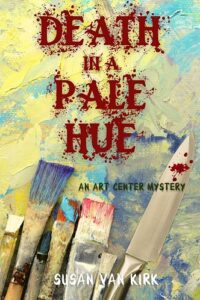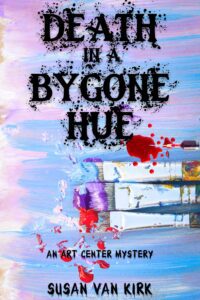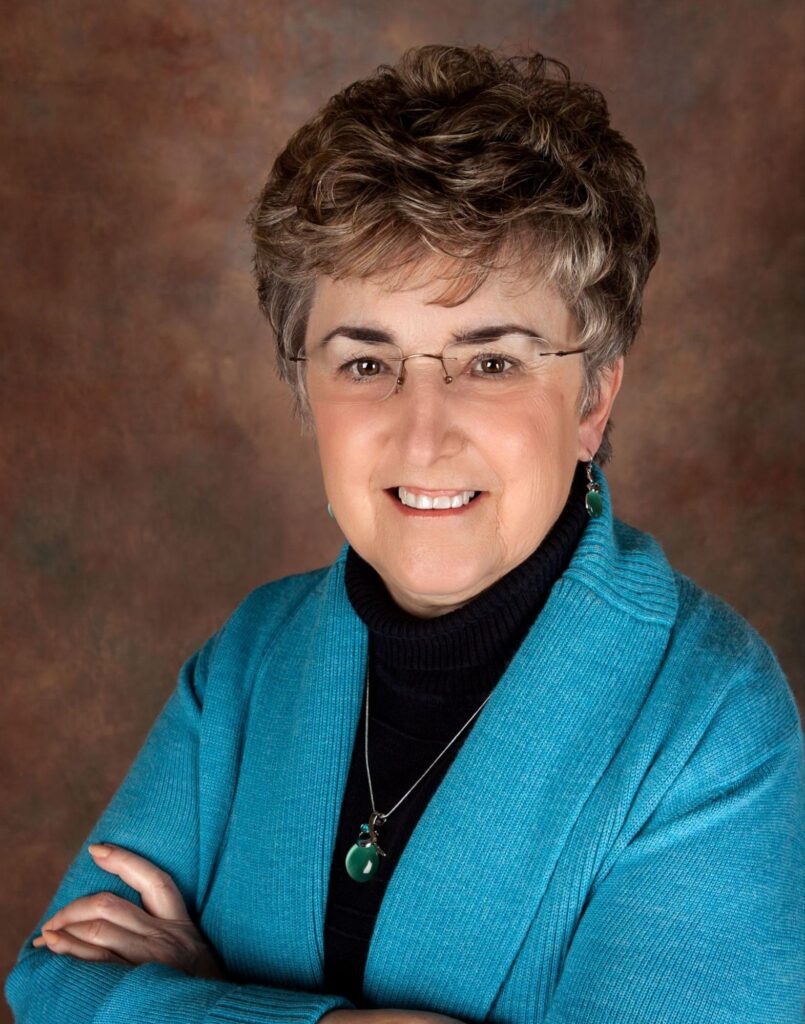 Recently, I read a blog post by writer Annette Dashofy in which she mentioned an idea that gave me pause. “As writers,” she wrote, “we tend to mine the emotional moments in our lives for story fodder.” This thought certainly rang true with me, but I hadn’t connected it to my most recent mystery series.
Recently, I read a blog post by writer Annette Dashofy in which she mentioned an idea that gave me pause. “As writers,” she wrote, “we tend to mine the emotional moments in our lives for story fodder.” This thought certainly rang true with me, but I hadn’t connected it to my most recent mystery series.
My Art Center Mysteries have a dark connection to my life, but one I hadn’t really considered until I let Annette’s writerly thought swirl around in my brain. The second book in the series, Death in a Bygone Hue, is just out, and it continues the story of Jill Madison begun in the first book, Death in a Pale Hue.
Like me, Jill has two brothers, but in a different order than mine, and she returns to the small Illinois town of Apple Grove to be executive director of an art center named for their sculptor mother. In the first book, she is shaky, her confidence at a low ebb. An oil painter by trade, she hasn’t painted in six years because of a horrific event that permeates the entire series, and the Madison children’s lives. Their parents died in a car accident with a drunk driver who hit them head-on.
Fortunately for Jill, despite a murder and an art theft, she is slowly wrapped in the love of her brothers and niece and nephew, and by the end of the first mystery, she begins to heal and is painting again. In the second book, Death in a Bygone Hue, the deaths of the Madison parents show up again when Jill discovers her friend and mentor, Judge Spivey, murdered. He was the treasurer of her art board, and they shared a love of art and conversations about her parents because he knew her parents well. With his death, a valuable connection to her parents and knowledge of their pasts is lost. Jill is shocked when she discovers an unbelievable secret in the judge’s past that might connect to her mom and dad.

The next book, currently in progress, Death in a Ghostly Hue, will also swirl around the deaths of the parents in a more direct way. The young person who was driving the car that killed the Madisons returns to town looking for a way to atone for his actions. It becomes apparent, in a very public scene, that there will be no forgiveness from one of Jill’s brothers. When the young man is murdered, you can imagine the identity of the main suspect.
Only recently, I thought about how this emotional fodder came from my own life. While my art mysteries are quite humorous, the framework beneath this is a bit somber. The Madison family drifted for a long six years, and the whole family dynamic and relationships among the three siblings changed. Had their parents lived, this family might have stayed intact, loving, and in close contact. A watershed moment in my own life was my mother’s young death from cancer. When she died at fifty-six, my older brother’s wife and I were both pregnant with our first children. Our younger brother was fifteen. Our mother never lived to see any of her grandchildren, while my father remarried a couple of years later. The family was never the same. It hadn’t occurred to me until I read Annette’s comment that I was living through and processing that moment with the Madison family. In fiction, as in real life, dramatic events occurring in a split moment change lives forever. I’m planning to give the Madisons a better ending. That’s why I like writing cozy mysteries—I can make things whole once again.
Summary of Death in a Bygone Hue

When Jill Madison returns to her hometown to become executive director of a new art center, she never dreams unexpected secrets from the past will put her life in danger. Her parent’s old friend and Jill’s mentor, Judge Ron Spivey, is murdered. He leaves behind more than a few secrets from the past. His baffling will makes Jill a rich woman if she survives the will’s six-month probate period.
She finds a target on her back when the judge’s estranged children return. They form an unholy alliance with a local muckraking journalist who specializes in making up the news. According to the judge’s will, if Jill dies, the family inherits.
Jill and her best friend, Angie Emerson, launch their own investigation determined to find the judge’s killer. In the meantime, Jill must run her first national juried exhibit, launch a new seniors group, and move the weavers guild into the art center. Easy peasy, right?
Susan Van Kirk is the president of the Guppy Chapter, the online chapter of Sisters in Crime, and a writer of cozy mysteries. She lives at the center of the universe—the Midwest—and writes during the ridiculously cold and icy winters. Why leave the house and break something? Van Kirk taught forty-four years in high school and college and raised three children. Now that the children are launched, she writes.
Her Endurance mysteries include Three May Keep a Secret, Marry in Haste, The Locket: From the Casebook of TJ Sweeney, Death Takes No Bribes, and The Witch’s Child. She also wrote A Death at Tippitt Pond. Her latest Art Center Mysteries include Death in a Pale Hue and Death in a Bygone Hue from Level Best Books. She is a member of Mystery Writers of America and Sisters in Crime.
Website: www.susanvankirk.com
FB http://www.facebook.com/SusanVanKirkAuthor/
Instagram: https://www.instagram.com/susanivankirk/
Goodreads www.goodreads.com/author/show/586.Susan_Vankirk

Thanks for sharing Susan’s books and her inspirations.
Thanks so much, Kathleen!
Appreciate you stopping by, Kathleen. Susan’s take on story fodder is most interesting.
It really is amazing learning how an authors stories are affected by life’s experiences whether large or small. Have an enjoyable week.
You too, Kat. Very mysterious the way the mind works.
What’s most interesting to me, Kat, is how the subconscious takes over without our even knowing it.
Amazing how our own lives creep into our stories. I continually draw from ancestors, relatives, and friends I’ve known in the past. Also from my own life story. Thanks for posting!
Mary, it is amazing how our own lives creep in. It gives true flavor to our writing.
And here I thought I was writing something new that had nothing to do with my own life. Sometimes I just shake my head!
Thank you, Susan, for telling us your story and how it infused your fiction. I think so much of our subconscious works with creativity and then surprises us with a connection. Often, it takes time to see how our lives inform our work as it did you.
Valerie,
I think that can also be interpreted when we decide a book or story isn’t going the right way and we go to make a change and realize we’ve already incorporated the right details (ex. changing the villain/killer).
Hi, Valerie, You are so right about surprises, the subconscious, and creativity. And here I thought my conscious mind was doing all the work.
Susan,
Thanks for stopping by today. Your blog about how your subconscious thoughts and your experiences influenced your new art series hits home for many of us.
Susan,
Thanks for stopping by today. Your blog about how your subconscious thoughts and your experiences influenced your new art series hits home for many of us. Looking forward to the third book in the series, having enjoyed the first two.
Thank you, Debra, for having me on your website. It’s always a treat to work with you and see what your readers think.
Susan, you tapped into your subconscious, subconsciously. So many say a similar thing happens with dreams coming up with answers to questions we’re struggling with, etc. I think it’s that spooky there-but-not-there quality that really awes us about our subconscious. Thanks so much for sharing this thought-provoking post with us.
Appreciate you leaving a comment … and I do agree that the subconscious and dreams create similar situations….. most thought provoking.
I agree with you about dreams, Pamela. Evidently, I don’t remember them as well as the ticking away of my subconscious when I write. It takes a while to figure out what I’ve done!